Apocleinae
Asilinae
Dasypogoninae
Dioctriinae
Laphriinae
Laphystiinae
Leptogastrinae
Ommatiinae
Stenopogoninae
Stichopogoninae
Trigonomiminae
Subfamilies
References: Artigas, J.N. & Papavero, N. (1988): The American genera of Asilidae (Diptera): Keys for identification with an atlas of female spermatecae and other morphological details. I. Key to the subfamilies and subfamily Leptogastrinae. - Gayana. Zoologia. Universidad de Concepcion, Instituto Central de Biologia 52(1-2): 95-114; Concepcion.
In addition: Williston, S.W. (1896): Manual of the families and genera of North American Diptera, 2.ed.. - New Haven, Connecticut: 167 pp. (52-60).
Williston, S.W. (1908): Manual North American Diptera, 3.ed. - New Haven, Connecticut: 405 pp. (192-204, 338). McAtee, W.L. & Banks, N. (1920): District of Columbia Diptera: Asilidae. - Proceedings of the Entomological Society of Washington 22: 13-33; Washington. Bromley, S.W. (1934): The robber flies of Texas (Diptera, Asilidae). - Annals of the Entomological Society of America 27: 74-113; Columbus. Curran, C.H. (1934): The families and genera of North American Diptera. - New York: 512 pp. (166-184). Bromley, S.W. (1946): Guide to the insects of Connecticut. Part VI. The Diptera or true flies of Connecticut. Third Fascile. Asilidae. - Bulletin of the State Geological and Natural History Survey of Connecticut 69: 1-48, 2 pls.; Hartford. Hull, F.M. (1962): Robber flies of the world. - Bulletin of the United States National Museum 224 (1, 2): 1-907; Washington. Adisoemarto, S. (1967): The Asilidae (Diptera) of Alberta. - Quaestiones entomologicae. University of Alberta 3(1): 3-90; Edmonton. Schaefer, K.F. (1968): The Asilinae (Diptera, Asilidae) of Oklahoma. - Proceedings of the Oklahoma Acadademy of Science 47: 114-124; Norman. Cole, F.R. (1969): The Flies of Western North America [Asilidae]. - University of California Press: 693 pp. (184-217). Rogers, L.E. & Lavigne, R.J. (1972): Asilidae of the Pawnee National Grasslands, in northeastern colorado. - University of Wyoming Agricultural Experiment Station Science Monograph 25: 1-35; Laramie. Papavero, N. (1973): Studies of Asilidae (Diptera) systematics and evolution. I. A preliminary classification in subfamilies. - Arquivos de Zoologia do Estado de Sao Paulo 23: 217-274; Sao Paulo. Baker, N.T. & Fischer, R.L. (1975): A taxonomic and ecologic study of the Asilidae of Michigan. - The Great Lakes entomologist 8(2): 31-91; East Lansing. Wood, G.C. (1981): Asilidae. In: McAlpine, J.F. et al.: Manual of Nearctic Diptera, Vol. 1. - Research Branch, Agriculture Canada, Monograph 27: 549-573; Ottawa. Nelson, C.R. (1987): Robber flies of Utah (Diptera: Asilidae). - Great Basin Naturalist 47(1): 38-90; Provo.
Abdominal tergite 1 five or more times as long as wide. Alula of wing lacking, anal cell reduced. Pulvilli of legs lacking . . . . . Leptogastrinae


| ||
Abdominal tergite 1 no more than four times as long as wide. Usually both alula and pulvilli present.

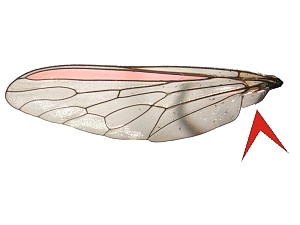
|
|
Fore tibia with an apical spur; one of the spines at the apex of the ventral side of the fore tibia differentiated, enlarged and stouter than remaining spines, or if not noticeably larger, twisted and sigmoid. Prosternum dissociated by a membranous area from proepisternum, except in Blepharepium . . . . . Dasypogoninae
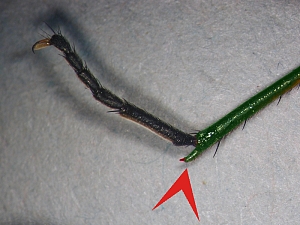
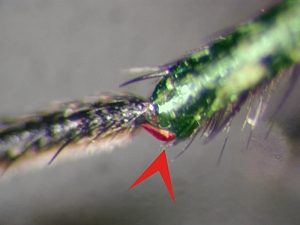
| ||
Fore tibia without an apical spur; all apical spines on fore tibia straight, or if one is slightly curved then it is not thickened or sigmoid. Prosternum either dissociated from proepisternum or fused to it.
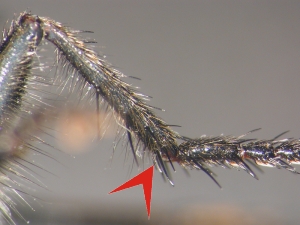
|
|
Apex of R2+3 directed sharply forward, meeting C at an angle of about 90°, ending either at distal end of R1 (cell r1 closed) or a short distance from R1 along C (cell r1 open). Vein R4 strongly sinuate and arched forward after separation from R5. Cells m3 and cup always closed before wing margin. Prosternum fused to proepisternum. Male with only six tergites visible dorsally . . . . . Laphystiinae
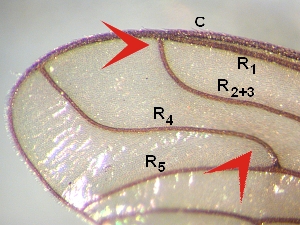
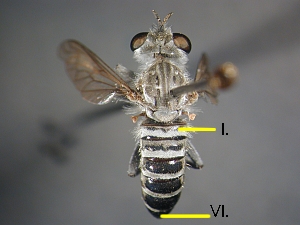
| ||
Apex of R2+3 not directed sharply forward before ending in C or R1. R4 not unusually arched and sinuate. Cells m3 and cup open to wing margin, or one of the two closed, or both closed. Prosternum dissociated from proepisternum or fused to it. Male with six to eight tergites visible dorsally.
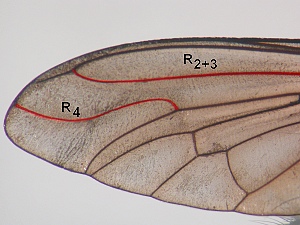
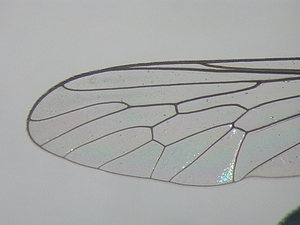
|
|
R2+3 ending in C.
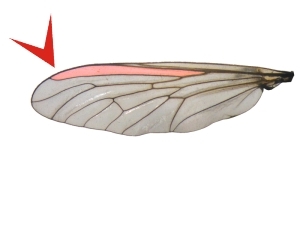
|
| |
R2+3 joining R1 proximal to end of R1, with cell r1 thus separated from wing margin.
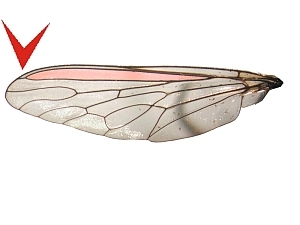
|
|
Prosternum dissociated from proepisternum by a membranous area . . . . . Stenopogoninae and Dioctriinae
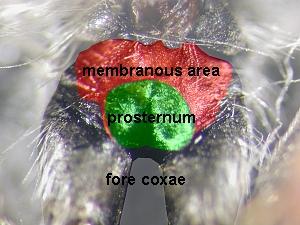
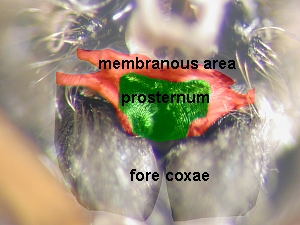
| ||
Prosternum fused to proepisternum, forming a precoxal bridge.
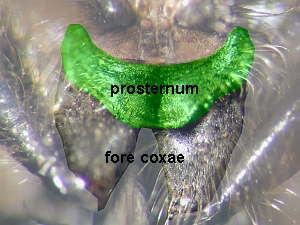
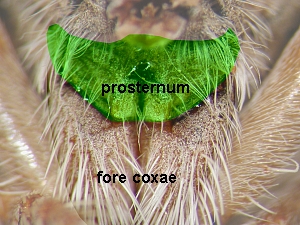
|
|
Frons narrowed at level of insertion of antennae and then suddenly and widely diverging towards apex, which is ectremely shallow (eyes much more distant at vertex than at antennal level). Face without tentorial pits or grooves, flat above and prominent below or very gibbose. Posterodorsal corner of metepimeron bare. Abdomen slender. Female terminalia with characteristic ventral keel and spines . . . . . Stichopogoninae
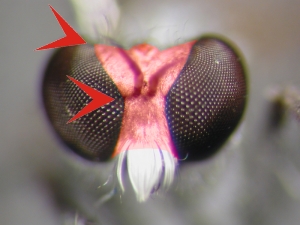
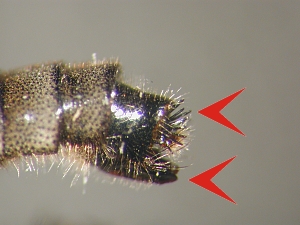
| ||
Frons approximately of same width at level of antennal insertion and vertex, the latter excavated (eyes not noticeably more distant at vertex then at antennal level). Face with pronounced tentorial pits or grooves extending well above lower facial margin. Face in profile not produced beyond eye margin. Posterolateral corners of metepimeron with short hairs. Abdomen very short, usually three-quarters or less width of wing. Female terminalia simple, tubular, without spines . . . . . Trigonomiminae
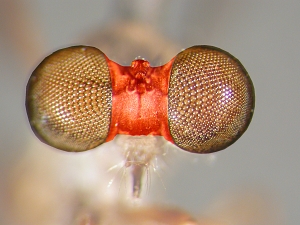
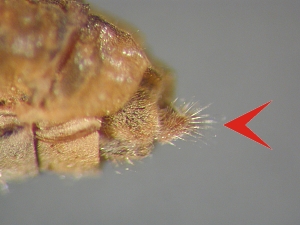
|
Supero-posterior angle of anepisternum, in front of wing insertation, with at least one strong, long bristle. Prosternum fused to proepisternum. Palpus, one or two-segmented. Female terminalia without spines . . . . . Laphriinae
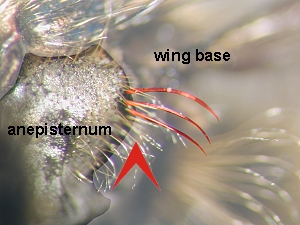
 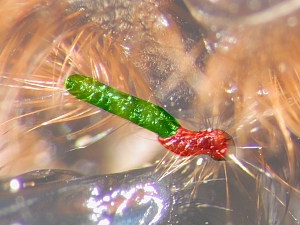
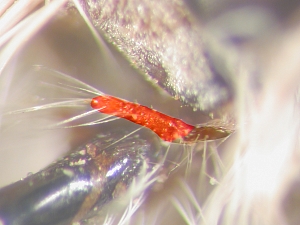
| ||
Supero-posterior angle of anepisternum never with a strong, long bristle. Prosternum dissociated from proepisternum or fused to it. Palpus always one-segmented. Female terminalia with or without spines.
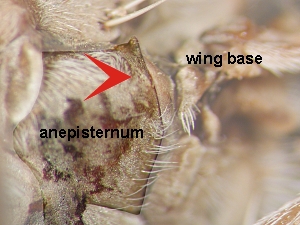
 

|
|
Anatergite pilose, the hair situated on top of it. R4 never with an extra vein . . . . . Asilinae [there are some few Asilinae with bare anatergite]
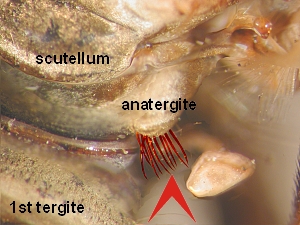
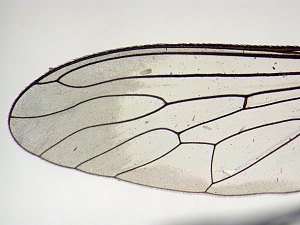
| ||
Anatergite bare, or if some hairs, these placed mostly on latero-internal margin of anatergite and on immediately adjacent area of mediotergite, but never on top of anatergite and R4, in this case, always with a short extra vein present at its junction with R5, the short vein ending in cell r2+3. [There are some few Neotropical Apocleinae with a pilose anatergite]
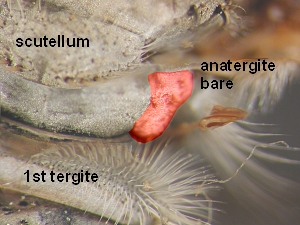
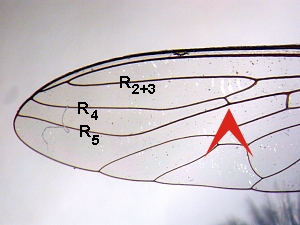
|
|
Antennal style plumose. Postmetacoxal area heavily sclerotized, forming a complete bridge behind hind coxae . . . . . Ommatiinae
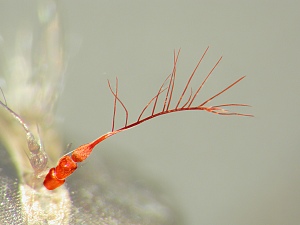
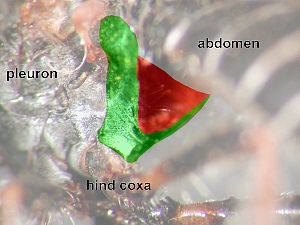
| ||
Antennal stylus bare. Postmetacoxal area membranous . . . . . Apocleinae
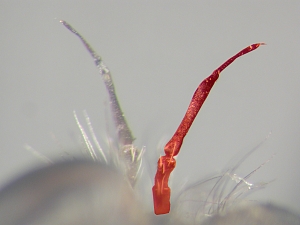
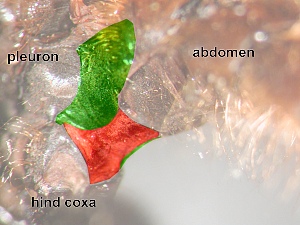
|
Contents: © Fritz Geller-Grimm, Jorge N. Artigas, 2007
Layout & images: © Fritz Geller-Grimm, 2007